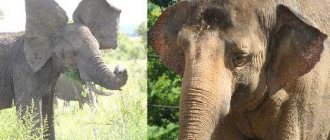- Wild animals
- >>
- Mammals
The Indian elephant is one of the largest mammals on Earth. The majestic animal is a cultural icon of India and throughout Asia and helps maintain the integrity of the ecosystem in forests and grasslands. In the mythology of Asian countries, elephants personified royal greatness, longevity, kindness, generosity and intelligence. These majestic creatures have been loved by everyone since childhood.
Origin of the species and description
Photo: Indian elephant
The genus Elephas arose in sub-Saharan Africa during the Pliocene and spread throughout the African continent. Elephants then moved to the southern half of Asia. The earliest evidence of the use of Indian elephants in captivity are seal engravings from the Indus Valley Civilization, dating back to the 3rd millennium BC.
Video: Indian elephant
Elephants occupy an important place in the cultural traditions of the Indian subcontinent. The main religions of India: Hinduism and Buddhism, traditionally use the animal in ceremonial processions. Hindus worship the god Ganesha, who is depicted as a man with the head of an elephant. Although revered, Indian elephants were not killed as aggressively as African elephants.
The Indian is a subspecies of the Asian elephant which includes:
- Indian;
- Sumatran;
- Sri Lanka Elephant;
- Borneo elephant.
The Indian subspecies is the most widespread among the other three Asian elephants. Domesticated animals were used for forestry and to fight in battles. There are many places in Southeast Asia where Indian elephants are kept for tourists and they are often mistreated. Asian elephants are famous for their enormous strength and friendliness towards people.
Food in captivity
Asian (African) elephants, living in captivity, feed mainly on hay and grass. Animals love sweets. Preference is given to apples, bananas, beets, and carrots. Elephants also enjoy flour products, especially cookies and bread. At the zoo, they eat up to thirty kilograms of hay per day, plus another fifteen kilograms of fruits, vegetables, and ten kilograms of flour products. They can also supplement animals with cereals, for example, giving up to ten kilograms of grain. Elephants' diet must include vitamins and salt.
Appearance and features
Photo: Indian elephant animal
In general, Asian elephants are smaller than African elephants. They reach a shoulder height of 2 to 3.5 m, weigh from 2000 to 5000 kg and have 19 pairs of ribs. The length of the head and body ranges from 550 to 640 cm.
Elephants have thick, dry skin. Its color varies from gray to brown with small spots of depigmentation. The tail on the body and the elongated trunk on the head allow the animal to make both precise and powerful movements. Males have unique modified incisor teeth, known to us as tusks. Females are usually smaller than males and have short or no tusks.
Curious! The brain of an Indian elephant weighs about 5 kg. And the heart beats only 28 times per minute.
Due to their wide variety of habitats, members of the Indian subspecies have several adaptations that make them unusual animals.
Namely:
- The torso has about 150,000 muscles;
- The tusks are used to uproot roots; they grow 15 cm per year;
- An Indian elephant can drink 200 liters of water every day;
- Unlike their African counterparts, its belly is proportional to its body mass and head.
Indian elephants have large heads but small necks. They have short but powerful legs. Large ears help regulate body temperature and communicate with other elephants. However, their ears are smaller than those of African species. The Indian elephant has a more curved spine than the African elephant, and its skin color is lighter than its Asian counterpart.
Elephants don't sweat
No matter how strange this fact about elephants may seem, they really do not sweat: they do not have sebaceous glands. In order not to “cook” in the heat, elephants use mud baths or ears. Elephants' ears are penetrated by a network of blood vessels, which, in extreme heat, expand and release heat very abundantly into the environment. During cold periods they narrow.
Where does the Indian elephant live?
Photo: Indian elephants
The Indian elephant is native to mainland Asia: India, Nepal, Bangladesh, Bhutan, Myanmar, Thailand, Malay Peninsula, Laos, China, Cambodia and Vietnam. Completely extinct as a species in Pakistan. It lives in meadows, as well as in evergreen and semi-evergreen forests.
In the early 1990s, wild populations were:
- 27,700–31,300 in India, where numbers are limited to four general areas: in the northwest at the foot of the Himalayas in Uttarakhand and Uttar Pradesh; in the northeast - from the eastern border of Nepal to western Assam. In the central part - in Odisha, Jharkhand and southern part of West Bengal, where some animals roam. In the south, eight populations are separated from each other in northern Karnataka;
- 100–125 individuals have been recorded in Nepal, where their range is limited to several protected areas. In 2002, estimates ranged from 106 to 172 elephants, most of which are found in Bardia National Park.
- 150–250 elephants in Bangladesh, where only isolated populations survive;
- 250–500 in Bhutan, where their range is limited to protected areas in the south along the Indian border;
- Somewhere between 4000-5000 in Myanmar, where numbers are highly fragmented (females predominate);
- 2,500–3,200 in Thailand, mostly in the mountains along the Myanmar border, with smaller numbers of fragmented herds occurring in the south of the peninsula;
- 2100–3100 in Malaysia;
- 500–1000 Laos, where they are scattered in forested areas, highlands and lowlands;
- 200–250 in China, where Asian elephants managed to survive only in Xishuangbanna, Simao and Lincang prefectures in southern Yunnan;
- 250–600 in Cambodia, where they are found in the mountains of the southwest and in the provinces of Mondulkiri and Ratanakiri;
- 70–150 in southern parts of Vietnam.
These statistics do not apply to domesticated individuals.
Lifestyle
Despite its massive build, the elephant is amazingly agile, easy to move and, if necessary, can move very quickly. It swims beautifully, with only its forehead and the tip of its trunk remaining above the surface of the water, overcomes steep climbs without visible effort, and feels free among the rocks. An amazing sight - a herd of elephants in the forest. Absolutely silently, the animals literally cut through the dense thickets. It seems that they are immaterial: no crackling, no rustling, no movement of branches and foliage. With an even, seemingly unhurried step, the elephant covers vast distances in search of food or escaping danger, walking tens of kilometers during the night.
Elephants rarely live alone. But the herds of many hundreds that travelers of the last century wrote about cannot be found now. The usual composition of an elephant herd is 9-12 old, young and very small animals. As a rule, there is a leader in the herd, most often an old elephant. However, sometimes males are the leaders, especially during migrations.
Elephant family
A herd of elephants is a very close-knit community. Animals recognize each other and work together to protect their young; There are known cases when elephants provided assistance to their wounded brothers, leading them away from a dangerous place. Fights between elephants are rare. Apart from humans, the elephant has almost no enemies. The elephant's voice is a shrill, shrill sound, simultaneously reminiscent of a hoarse horn and the screeching of car brakes.
Social behavior
Elephants lead a nomadic lifestyle; a group usually consists of 9-12 animals belonging to the same family (a female and her cubs) or united by friendly ties. The route is chosen by the most active and wise female (matriarch). According to scientists, elephants that live in the forest differ in behavior from their counterparts living on the plains. Their cubs leave their mother and move on to independent life much earlier. This is due to the fact that in the savannahs young elephant calves are threatened by lions, and therefore early separation of the calf from its mother threatens its death. In forests there is no such danger, which allows them to gain independence earlier.
What does the Indian elephant eat?
Photo: Asian Indian elephants
Elephants are classified as herbivores and consume up to 150 kg of vegetation per day. In an area of 1,130 km² in southern India, elephants have been recorded feeding on 112 species of different plants, most commonly legumes, palms, sedges and grasses. Their consumption of greens depends on the season. When new vegetation appears in April, they eat the tender shoots.
Later, when the grasses begin to exceed 0.5 m, Indian elephants uproot them with clods of earth, skillfully separate the soil and consume the fresh tops of the leaves, but discard the roots. In autumn, elephants clean and eat succulent root vegetables. In bamboo, they prefer to eat young seedlings, stems and side shoots.
During the dry season from January to April, Indian elephants roam on leaves and branches, preferring fresh foliage, and consume the thorny shoots of acacia trees without any apparent discomfort. They feed on black locust bark and other flowering plants and consume the fruits of tree apple (feronia), tamarind (Indian date) and date palm.
It is important! Declining habitat is forcing elephants to seek alternative food sources from the farms, settlements and plantations that have grown up in their ancient forest lands.
In Nepal's Bardiya National Park, Indian elephants consume large amounts of winter floodplain grass, especially during the monsoon season. During the dry season, they focus more on bark, which forms the bulk of their diet during the cool part of the season.
During a study in a 160 km² tropical deciduous area in Assam, elephants were observed feeding on approximately 20 species of grasses, plants and trees. Such grasses, like leersia, are far from the most common component of their diet.
Elephants live in herds
Female elephants live in herds of 10-15 individuals. They raise their young together and take care of each other: they can bring water or food to an elephant that has been injured in some way and cannot move. Elephant cubs live in a herd until they are 12-14 years old, after which they can either stay or separate and start their own family. Male elephants prefer solitude, but close to a herd. An elephant can only leave its herd if it dies or is caught by people.
Elephants live 40-60 years. The oldest elephant is Lin Wang from Taiwan, who died in 2003 at the age of 86. This elephant served in the Chinese army and fought during the Second Sino-Japanese War (1937-1945).
Features of character and lifestyle
Photo: Indian elephant animal
Indian mammals follow strict migratory patterns that are determined by the monsoon season. The eldest of the herd is responsible for remembering the travel routes of his clan. The migration of Indian elephants usually occurs between the wet and dry seasons. Problems arise when farms are built along the migratory routes of the herd. In this case, Indian elephants cause great damage to newly established agricultural lands.
Elephants tolerate cold more easily than heat. Usually at midday they are in the shade and flap their ears in an attempt to cool their bodies. Indian elephants douse themselves with water and roll in the mud, protecting their skin from insect bites, dryness and burns. They are very mobile and have an excellent sense of balance. The design of the foot allows it to move even through wetlands.
A disturbed Indian elephant moves at speeds of up to 48 km/h. He raises his tail, warning of danger. Elephants are good swimmers. They need 4 hours of sleep every day, and they do not lie down on the ground, with the exception of sick individuals and young animals. The Indian elephant has an excellent sense of smell and acute hearing, but poor eyesight.
This is interesting! The elephant's huge ears serve as a hearing amplifier, so its hearing is significantly superior to that of humans. They use infrasound to communicate over long distances.
Elephants have a diverse range of calls, roars, squeals, snorts, etc., which they share with their relatives about danger, stress, aggression and demonstrate affection for each other.
Why does an elephant need a trunk?
The trunk is a universal tool and the calling card of any elephant. With the help of its trunk, the animal breathes, eats, drinks, takes water procedures and trumpets loudly in case of danger.
By the way, about sounds. The elephant emits signals of such low frequency that the human ear is unable to detect them. The same cannot be said about the perception of sounds by the giants themselves, because elephants are able to hear each other at a distance of up to 19 km!
In case of danger, elephants can make very loud trumpet sounds that will leave the enemy in awe. There is another type of elephant signal - a quiet tickle, similar to either a rumbling stomach or the sound of brake pads.
Social structure and reproduction
Photo: Indian elephant calf
Females usually create family clans consisting of an experienced female, her offspring, and young elephants of both sexes. Previously, herds consisted of 25-50 heads and even more. Now the number is 2-10 females. Males lead a solitary life, except during mating periods. Indian elephants have no special mating time.
By the age of 15-18 years, male Indian elephants become capable of reproduction. After this, every year they fall into a state of euphoria called must (“intoxication”). During this period, their testosterone levels increase significantly, and their behavior becomes very aggressive. Elephants are becoming dangerous even to humans. The must lasts about 2 months.
Male elephants, when ready to mate, begin to flare out their ears. This allows them to spread their pheromones, released from the skin gland located between the ear and eye, over a greater distance and attract females. Older males, between 40 and 50 years old, usually mate. Females are ready to breed at 14 years of age.
Interesting fact! Younger males usually cannot withstand the strength of older ones, so they do not marry until they are much older. This circumstance makes it difficult to increase the number of Indian elephants.
Elephants hold the record for the longest period of time from conception to birth of offspring. The gestation period is 22 months. Females are capable of giving birth to one young every four to five years. At birth, elephant calves are one meter tall and weigh about 100 kg.
A baby elephant can stand soon after birth. He is cared for not only by his mother, but also by other females of the herd. The Indian elephant calf stays with its mother until it is 5 years old. Having gained independence, males leave the herd, but females remain. The lifespan of Indian elephants is about 70 years.
Interesting facts about Asian elephants
- Do you know that elephants cry? And they endure the conditions of captivity very hard, because they are not able to exist without their family and give birth in complete isolation from elephant society.
- Elephants are so amazing! These are the only animals in the world that bury their dead relatives. When a herd of giants finds the body of a dead comrade, they first cover it with small twigs and numerous leaves, and then take turns mournfully guarding the corpse for several days. Next, the elephants take turns sniffing the bones, picking up a rib or thigh with their trunk and throwing the limbs into a hole dug in the ground.
- Elephants are practically silent animals, despite their impressive size. They walk extremely quietly, because under the sole of their feet the giants have a soft elastic mass, as if softening the sounds of steps.
- Elephants are excellent swimmers! The animal uses its trunk to breathe underwater.
- We have already said that elephants cry like people. But we did not indicate exactly when they cry. And these animals cry in difficult life situations! Sometimes a crying elephant can be found in captivity.
- Male Asian elephants leave their natal herds when they reach sexual maturity. Young males travel alone or gather in bachelor herds. Adult males prefer a solitary life.
- Female Asian elephants only mate with large, dominant males who have higher testosterone levels.
- The Asian elephant lives in large family groups (herds) consisting of closely related females and their offspring. The oldest, largest and most experienced female - the matriarch - is the leader of the herd.
- The Asian elephant eliminates excess heat from the body through its large ears. On very hot days it usually hides in the shade of trees or in the water. An Asian elephant sprays water and mud on its back to prevent overheating.
- Elephants are extremely intelligent animals. They have huge brains, a highly developed self-awareness, and the ability to learn to use tools.
- The elephant is one of the rare animals that can recognize its reflection in the mirror.
- The Asian elephant can reach 21 feet in length and weigh up to 11,000 pounds.
- The Asian elephant has a dark gray-brown body. Pink skin can only be seen on certain parts of the forehead, ears, torso and chest.
Which view do you like best, our precious reader? A huge African elephant or an Indian elephant with cute and slightly pointed ears?
We will be glad if you answer our question in the comments.
It's not scary when they make a mountain out of a molehill. But an elephant under a fly is really dangerous.
Folk wisdom
Natural enemies of Indian elephants
Photo: Great Indian elephant
Due to their enormous size, Indian elephants have few predators. Besides tusk hunters, tigers are major predators, although they often hunt elephant calves or weakened animals rather than larger, stronger individuals.
Indian elephants form herds, making it difficult for predators to defeat them alone. Single male elephants are very healthy, so they are not often hunted. Tigers hunt an elephant in a group. An adult elephant can kill a tiger if it is not careful, but if the animals are hungry enough, they will take the risk.
Elephants spend a lot of time in the water, so young elephants can become victims of crocodiles. However, this does not happen often. Most of the time, young animals are safe. Hyenas also often hang around the herd when they sense signs of illness in one of the group members.
Interesting fact! Elephants tend to die in a certain place. This means that they internally feel the approach of death and know when their time will come. The places where old elephants go are called elephant cemeteries.
However, the biggest problem for elephants comes from humans. It is no secret that people have been hunting them for decades. With the weapons that people have, animals simply have no chance to survive.
Indian elephants are large and destructive animals, and small farmers can lose all their property overnight to their raid. These animals also cause great damage to large agricultural corporations. Devastating raids provoke retaliation and people kill elephants in retaliation.
Silent as an elephant
The average weight of an elephant is 12 tons, but they walk very quietly. You will hardly notice if an elephant calmly approaches you from behind. The thing is that the ball of an elephant’s foot is designed in such a way that it can spring and expand, taking up more and more space as space is transferred to it: imagine that you glued a feather pillow to your sole - about the same thing with elephants. That is why they walk through swamps with ease.
Population and species status
Photo: Indian elephant
The growing population of Asian countries is looking for new lands to live in. This also affected the habitats of Indian elephants. Illegal encroachment into protected areas, clearing forests for roads and other development projects are leading to habitat loss, leaving little room for large animals to live.
Displacement displacement not only leaves Indian elephants without reliable sources of food and shelter, but also leaves them isolated in a limited population and unable to follow their ancient migration routes and mix with other herds.
Also, the population of Asian elephants is declining due to poachers who are interested in their tusks. But unlike their African counterparts, only males have tusks in the Indian subspecies. Poaching distorts the sex ratio, which contradicts the reproduction rates of the species. The level of poaching is increasing due to the demand for ivory by the middle class in Asia, despite the fact that there is a ban on the ivory trade in the civilized world.
On a note! Young elephant calves are taken from the wild from their mothers for Thailand's tourism industry. Mothers are often killed, and elephant calves are placed next to non-native females to hide the fact of the abduction. Elephant calves are often subjected to “training,” which includes restricting movement and fasting.
African elephant species
Currently, science knows of 2 species of elephants living in Africa: savannah and forest .
Savannah elephant
The savannah elephant inhabits the expanses of the plains; it is larger in size than the forest elephant, dark in color and has characteristic processes at the end of its trunk. This species is distributed throughout Africa. It is the savannah elephant that is considered to be African, as we know it. In the wild, these two species rarely intersect.
forest elephant
The forest elephant is smaller, gray in color, and lives in the tropical forests of Africa. In addition to their size, they differ in the structure of their jaws; they are narrower and longer than those of the Savannah. Also, forest elephants have four toes on their hind legs, while savannah elephants have five. All other differences, such as small tusks and small ears, are due to the fact that it is convenient for them to pass through dense tropical thickets.
Elephants were used in war
There is nothing more impressive than a five-ton elephant adorned with intricate armor and sharp spears attached to its tusks. Using animals in war was a way to instill fear in the enemy - or at least it wasn't more than 2,000 years ago when pachyderms were conscripted into the ranks of armies. The use of war elephants peaked around 400-300 BC. and continued until the invasion of Rome through the Alps in 217 BC. After this, elephants were still used in the civilizations of the Mediterranean basin, and were also common among Indian and Asian military leaders. However, at the end of the 15th century, when gunpowder began to be used, an elephant could easily fall after being shot.
Elephants are extremely intelligent animals
In the truest sense of the word, elephants have huge brains - up to 5.5 kg for adult males, compared to 1-2 kg for the average human (however, elephants' brains are much smaller than humans, in relation to body weight). Elephants not only know how to use their trunk as a tool, but also demonstrate a high degree of self-awareness (for example, recognizing themselves in the mirror) and empathy for other members of the herd. Some elephants have even stroked the bones of their dead relatives, although naturalists disagree on whether this proves a primitive understanding of death.
Elephants are an important part of their ecosystems
Regardless, elephants have an important impact on their habitat. They uproot trees, compact the ground underfoot, and even deliberately widen water holes to allow for relaxing baths. Such actions benefit not only the elephants themselves, but also other animals in the ecosystem that benefit from these habitat changes. For example, African elephants are known to dig caves on the sides of Mount Elgon on the Kenya/Uganda border, which are then used as shelter by bats, insects and smaller mammals. When elephants eat in one place and defecate in another, they function as important seed carriers. Many plants, trees and shrubs will have difficulty surviving without their seeds being present in elephant feces.











